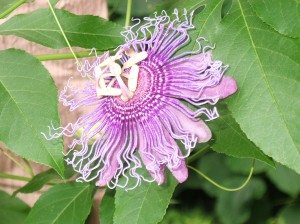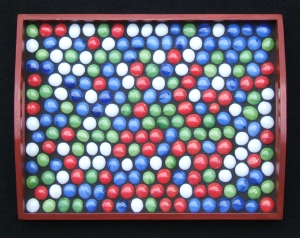Probability
Today I present you with a piece of frivolity- a tray made as randomly as I could manage with glass blobs, which turned out to be quite regular in form, if not color. Having four colors of glass blobs to start with, I held my tray at a slight tilt while placing blobs from my pile, and without regard to color, onto the surface of the tray and letting them settle where they would. As the tray filled up with blobs, I shook it gently to settle the blobs and put as many more onto the surface as would fit. Even after the tray was ‘full’, it was surprising how many more blobs would fit after yet another gentle shake. I’m sure it is no surprise to you that the pattern of blobs turned out to be the most efficient available; that is rows of blobs alternately settling into the little nests created by the previous rows and the subsequent rows. The pattern breaks down a bit at the ends where the next available space wasn’t zero, because I had no half-blobs to settle close to the edges of the tray, and the whole blobs maximized the little space remaining. Someone smarter and more patient than I could figure the probability of how many blobs of each color would end up on the tray, and the likelihood of each of the possible configurations of colors. By the way, after the blobs had settled themselves, I simply plucked each one up, applied my favorite mosaic adhesive to it, and dropped it back into place with its neighbors. The tray looked innocent and child-like, rather like an old-fashioned gumball machine, with the light wood background showing through; however, when I grouted it in almost-black, it took on a more grown-up and sophisticated air.
On a related note, a set of books which I think are delicious is the Hitchhiker’s Guide to the Galaxy. There are five books in this humorous, satirical science-fiction series by the late Richard Adams. I discovered them years ago when my son was about 14 and was presented with them by a friend of his; this tells you something about the sort of folks who might enjoy reading them. Among other science-fiction wonders, they introduce us to the Infinite Improbability Drive, which impels a spaceship, The Heart of Gold. This drive is based on the improbability of physical events in the universe, such as my instantaneously morphing into a sofa, happening, and thus the ship can subvert what we think of as normal physics by operating on the most improbable forces not-possible. This is an excellent plot device for an author who has written himself into a corner. By the way [BIG SPOILER ALERT!] in this series of books, we also discover that THE answer to life, the universe, and everything is 42. But, then you PROBABLY already knew that, right?
On a somewhat related note, I want to share a wonder of nature that regularly appears in my back yard this time of year- the native Passiflora incarnata, or Passionflower. I try to imagine the number of possible configurations and consistencies of petals, sepals, pistils, and stamens which could fill this ecological niche successfully, and yet, this improbable flower is the one doing the job.

Passiflora incarnata
Greetings and “Blessed Eid” to the Muslim friends here in town. In our city, it would be difficult to be in a technical or scientific field and not work with someone who is Muslim. Thanks to Muslims who upheld much of the rational, mathematical, and scientific part of the human experience for centuries, ultimately allowing my country’s culture to flourish through its first two hundred-plus years.

